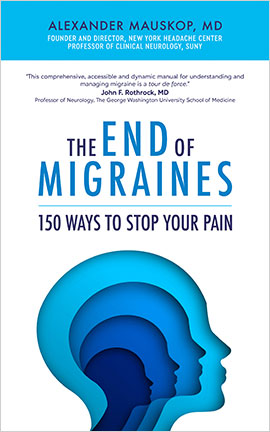Reviewing a weather forecast could be more accurately described as reviewing a potential migraine forecast. When so many different types of weather can be responsible for triggering a migraine attack, checking this migraine forecast can help you plan for what the day might bring.
Weather-related migraine triggers are wide and varied. Most people aren’t affected by all of them, but there are usually a couple of situations that will trigger those that are sensitive to weather. Approximately 40% of people with migraine identify weather as a reliable trigger.
Weather-related triggers include:
- Barometric pressure changes
- Bright sunny days
- Significant changes in temperature during the day and season to season
- Very hot or cold weather
- Sun glare or somewhat cloudy days that enhance brightness of clouds
- Snow glare
- High humidity
- Dry air
- Windy or stormy weather
- Lightning – especially within 25 miles of where you are (4)
Looking at all of these potentially migraine triggering weather conditions, you might wonder when weather isn’t a trigger! Stick with me while we explore why these particular conditions can trigger attacks and what steps might help mitigate some of weather’s effect on your migraine attacks.
***While Migraine Strong writes about the latest in migraine treatments, this is not medical advice. We are patient educators and all information you read should be discussed with your doctor.
Why does weather trigger migraine?
There have been many studies done on daily and seasonal weather and its affect on migraine or headache. Some studies have found no correlation and others have noted specific weather patterns that can trigger migraine attacks. As with most things related to migraine, determining if weather is a trigger is complicated by not always being triggered by the same type of weather. It is likely a combination of factors that contribute to weather as a trigger for migraine.
The Bucket Theory is one aspect of migraine management that is considered when migraine is brought on by weather. Other triggers that are already in our bucket could be at least partially responsible for weather getting the better of us. These triggers include things like lack of sleep, hormones, stress and food and beverages.
When weather changes are bearing down on us, that is the time for us to make sure we are on point controlling all of our other potential triggers. Ensuring that we use the Treatment Pie and stick to our sleep schedule, eat regularly, maintain hydration and reducing any other personal triggers can help lessen the triggering potential of weather.
Can barometric pressure changes forecast a migraine attack or a sinus headache?
Our sinuses (forehead, eye area and behind the nose) are made up of pockets of air. The pockets of air are at equilibrium with the atmosphere. When there are changes, it changes the pressure in the pockets of air in the sinuses. This sinus pressure is sometimes referred to as a sinus migraine. We have another article that explains how sinus headache is almost always migraine.
This change in pressure is part of why migraine can be triggered by the weather. ‘A low-pressure environment worsens pain by promoting the sympathetic activity, which in turn causes local vasoconstriction and ischemia.’ (1)
A study in 2015 found that the following steps happen in the mechanism of action for triggering a migraine attack:
- First, a small decrease in barometric pressure causes dilatation of cerebral blood vessels, leading to serotonin release from platelets,
- Increased levels of blood serotonin induce vasoconstriction and the onset of aura
- The subsequent decrease of serotonin causes rapid dilatation of cerebral blood vessels, thereby triggering migraine. (2)
Can cold weather cause headaches?
Temperature changes can also trigger a migraine attack. Cold weather is generally preceded by barometric pressure falling. A big change in temperature can affect our migraine no matter if it is an increase or decrease in temperature. This study ‘also found that an increase in temperature and atmospheric pressure corresponded to increased pain ratings in MH [migraine headache] patients’. (1)
Seasonal changes that can trigger migraine attacks
Each season brings on its own set of changes and challenges. Some of us might feel better in winter and some better in summer. The key is to recognize which seasons affect YOU. The way the season might affect us include:
- Fall – We transition into cooler weather (temperature fluctuation) and the humidity is decreasing. It tends to be darker and more windy in the fall. We also see a decrease in daylight for shorter days overall. Because of this change in daylight, our sleep times might fluctuate. Sleep must be kept consistent to avoid being a trigger.
- Winter – Cold temps brings about drier air and some of us feel the fluctuations in barometric pressure with snow storms. The drier air from the furnace tends to dehydrate us and we need to increase our water intake, or at least maintain it. Dehydration is a known migraine trigger.
- Spring – In Spring we have several changes all at once. Warmer temperatures and large temperature fluctuations between night and day, rainy spring storms (pressure change), flowers (pollen or allergen). Allergens can be a migraine trigger due to inflammation in the sinus cavities (pockets). All three together are a big migraine whammy.
- Summer – Heat (temp fluctuation), humidity (pressure change and dehydration due to heat). Dehydration is partly due to sweating more in the heat. Prolonged daylight (schedule changes with sleep). Vacation (sometimes when we are without stress we can have a stress let down headache). And we can also have headache from sun exposure.
Transitioning from season to season
With all of this fluctuation in weather, it’s so important to be aware of the other triggers that can fill your bucket. Especially when transitioning from one season to the next. It’s especially worth noting weather conditions around the change of season if you are also making a change in your diet, preventive medications or other preventive measures.
If you are prone to being triggered by weather, the change of season tends to be a time with more migraine attacks. Make sure to take the migraine forecast into account before blaming food or other preventive measures for the increase in attacks.
Weather headache relief tips – natural remedies for barometric pressure headaches
So how do we go about dealing with all of these changes in weather? It’s important to keep in mind that the migraine brain loves schedules and consistency. Try to keep the following in mind to help your migraine brain be more agile with the adjustments it needs to make.
- Sleep schedule – Be consistent during the fluctuations. Set a time to wake up and go to bed daily. Even on the weekends.
- Eat regularly – Try not to skip meals. Keep snacks handy at work in case meetings go over or limit your lunch time. Blood sugar fluctuations are a known migraine trigger.
- Exercise regularly – A daily walk is just as good for the migraine brain as a full out boot camp class, maybe better if you are triggered by exercise. We are suggesting more movement, not specific movement. Chair yoga is also good if your mobility is limited.
- Eliminate other triggers – Are you suspicious of your afternoon Diet Coke and Snickers (maybe that was just me)? During weather fluctuations, skip anything that you feel has potentially triggered you in the past. This is not the time to play chicken with avocado or banana if they have proven to be a potential problem.
Strategies for a migraine forecast
- Fall – Wear a hat or scarf when it’s windy. While this might not eliminate attacks, it can help lower the level in your bucket of triggers. If you are allergic to ragweed, consider asking your doctor about taking an allergy medication such as Zyrtec or Claritin.
- Winter – Increase water to eliminate dehydration. A humidifier running in your home can help with the dryness. Dust mites can also cause allergy issues and an antihistamine might be appropriate, check with your doctor.
- Spring – The pollen in the air can be problematic for many of us. Check with your doctor about adding an allergy medication. Stay inside during the worst pollen counts.
- Summer – Hydrate, hydrate, hydrate. We tend to underestimate what we actually drink. Measure your water intake by getting a glass, cup or water bottle you like and set a goal for drinking the number of full ones you need to get to the right level. Our blog on hydration and migraine is a great place to start for this information. There is also an increase in allergens from trees, pollen and grass. Talk to your doctor about treating these allergies if you have them. And if sun is a trigger, wear a hat, sunglasses and maybe an Ice Towel to help you stay cool.
Natural remedies for barometric pressure headaches
I have been searching for remedies to help me manage weather related attacks for years. I have found that the more on point I am with my preventive routine (preventive medications, hydration, exercise and meditation) the easier it is for me to manage an incoming weather front. Below are a few things that I have used over the years and found helpful.
- WeatherX app and earplugs – These pressure filtering earplugs help you adjust to the incoming pressure fluctuations. I have used them for a few years and find they help me mange fluctuations in pressure much like the EarPlanes help with pressure during flight.
- Supplements – While supplements aren’t recommended specifically for weather changes, taking the recommended migraine supplements can help to reduce the overall level of triggers in your bucket. Ginger, magnesium, Riboflavin (B2), CoQ10, Feverfew and Turmeric can all have a positive preventive effect on migraine. Ginger can also be used for treating migraine attacks.
- Glasses for migraine light sensitivity – Whether it is TheraSpecs, Migraine Shields (20% off with code MIGRAINESTRONG) or other migraine specific glasses, they can offer protection from the sun and glare. Preventive medications as well as the Allay Lamp can also reduce the pain from light sensitivity.
Medications to treat barometric pressure headache
While there are no specific medications to treat barometric pressure headaches, it is a good idea to keep the medication you use to treat migraine attacks close at hand. Treating early is still the best option for getting control over any attack.
Diamox (acetazolamide) is for high pressure headaches, glaucoma, as a diuretic and other conditions. It can also be used when adjusting to high altitude or treating high altitude sickness, as is sometimes seen when visiting places like Colorado. According to Dr. Alexander Mauskop, some of his patients found that Diamox helped rid them of migraine attacks triggered by barometric pressure changes. You can read about it on his blog. (3)
If you are consistently triggered by weather conditions and are having more than four attacks per month, contact your doctor to see if a preventive medication would be right for you.
Migraine Strong Supplement Dispensary
Plan on talking with your doctor if you are thinking of supplementing with the recommended supplements for migraine. Then check out the supplement dispensary on our website for many products and brands. You’ll receive a discount on your purchase along with special promotional savings.
Image by WikimediaImages from Pixabay
References:




Thank you for this information! I finally got diagnosed with migraines several years ago, and I learned a lot from this. The idea of a treatment pie is such a great visual. Going to go check out that post!
Thank you so much for this information. While everyone I know is anticipating the change of seasons, I dread them because they bring on steady migraines. I take preventative meds but during change of seasons, they don’t go much. But your article gave me more ideas plus it’s good info I can pass on to family who just don’t understand.
So glad you found it useful!! The change of seasons is so challenging for many of us! <3 Eileen
You should probably update the article this video. I found it very instructive.
It explains how weather and migraine works, as well as compares different apps and websites as regard to prediction capabilities! accuweather, Migraine Buddy, Weather X, Zutsuru.
https://www.youtube.com/watch?v=LB9mwlMY89I
Very helpful article. Thank you!